| A search of the Louisiana Bayou:
For the Congo Eel
|
| Going to the Acchafalaya swamp in Louisiana was one of the eeriest adventures I've ever had. Not only are there a lot of unusual animals,
but all the Spanish moss-covered trees and murky water made this
one of my spookiest treks yet!
|
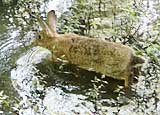 |
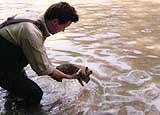 |
I found a swamp rabbit, one of the most unusual animals in the swamp. I actually had to dive into the water to catch the rabbit. This rabbit can swim -- and it even dives underwater holding its breath! It "recycles" by eating its own droppings, the "rabbit pellets." |
| That way the swamp rabbit can get any other nutrients still left. The rabbit is also built for speed on land, capable of running 25 miles an hour. This place also has an eerie legend, the tale of the swamp creature called the "Loup Garou" -- part vampire and part werewolf. But I'm not
superstitious, so the Loup Garou doesn't frighten me!
|
| This swamp is big -- 140 miles long and 15 miles wide -- so I used a swamp boat to get around. There's a lot to see, since it's home to 65 types of reptiles and amphibians. Our target creature is a strange legless reptile that looks like an eel but isn't -- the amphiuma. |
 |
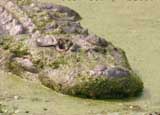 |
And this place can be dangerous! I spotted a noisy alligator who was a bit too close for my comfort. They may look slow and clumsy, but they can move fast when they're ready to strike. They sit in the water with just their eyeballs breaking the surface as they slip closer and closer.
|
| And there's good eating to be found in the swamp. I dug in the muck and pulled out a crawfish. These animals look like lobsters, but they actually belong to a family called "decapods," because they have ten legs.. I got a jar and started to collect some … for dinner later! (Remember: I am a trained biologist -- don't try this yourself!) |
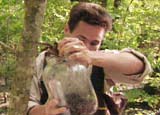 |
| Spanish moss is everywhere here. Spanish moss really isn't moss at all, but something called an "epiphyte." It actually gets its nutrients from the trees that it covers. People used to use the moss in pillows -- which I don't recommend since little chigger bugs live in the moss and they will bite. |
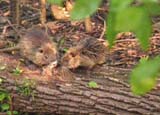 |
I also spotted a nutria, a rodent that has adapted to aquatic life in the swamp. On each paw, the nutria has four webbed fingers, and one free finger for digging and clawing. |
| As I walk around I see bubbles popping up around me in the water. And no, it's not the Loup Garou. Its swamp gas -- bubbles of methane, hydrogen sulfide and ammonia made by all the organic decaying matter under the water. And let me tell you -- it smells bad!
I almost miss seeing a little "swamp chameleon." Called a green anole, it's not a chameleon at all but more like an iguana. It has adhesive pads that let it hold onto slippery surfaces, and its color helps it blends into the foliage, which is a great fakeout Green Anole
I went to my friend Darrow, who lives in a cool swamp houseboat. Not only does he cook up my jar of crawfish, a staple of Cajun cooking, but he directs me to a spot where I can find the amphiuma. Jeff at Darrow's
And directing me to the amphiuma isn't all Darrow does. He tells me that throwing a green tree frog and salt at the Loup Garou makes it burst into flame. Again, I'm not superstitious -- but when I spot a green tree frog I put it in a jar …for, ahem, later scientific study.
Then, in the dark, eerie swamp, I find an amphiuma! The long, legless creature sure looks like an eel -- but when I finally snare it in a net I can see that it has two small feet in the front and two in the back. These limbs are called vestigial -- which means they're useless. The amphiuma is actually the longest salamander alive -- and a mighty strange animal to catch in the middle of the night.
Well, I let my frog go since no Loup Garou appeared and my swamp adventure was over. But I won't soon forget my night trek in that Louisiana swamp.
-Totally wild,
Jeff
|